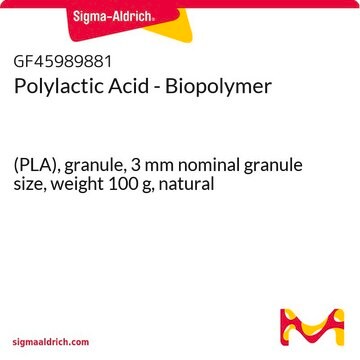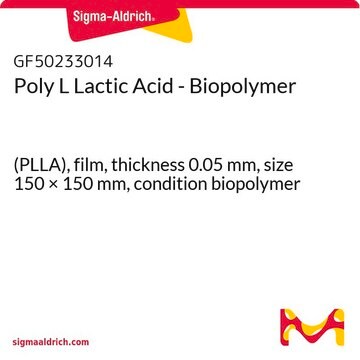38534
Polylactic acid
Mw ~60,000
Synonym(s):
Poly(2-hydroxypropionic acid)
About This Item
Recommended Products
form
solid
shelf life
limited shelf life, expiry date on the label
mol wt
Mn ~30,000
Mw ~60,000
InChI
1S/C3H6O3/c1-2(4)3(5)6/h2,4H,1H3,(H,5,6)
InChI key
JVTAAEKCZFNVCJ-UHFFFAOYSA-N
Looking for similar products? Visit Product Comparison Guide
General description
Application
It can be used to prepare PLA/polyvinyl alcohol wound dressing membrane through electrospinning and coating method. The coating of PLA improves the mechanical strength of nanofiber and acts as a protective layer to control the release of drug to the wound site.
It can also be used to synthesize free-standing, flexible ultra-thin PLA nanofilms which can act as a matrix for adhesion, spreading, and proliferation of skeletal muscle cells.
Features and Benefits
- Biocompatibility
- Lower toxicity
- Low cost
- Better encapsulation
related product
Storage Class Code
11 - Combustible Solids
WGK
WGK 3
Flash Point(F)
Not applicable
Flash Point(C)
Not applicable
Personal Protective Equipment
Certificates of Analysis (COA)
Search for Certificates of Analysis (COA) by entering the products Lot/Batch Number. Lot and Batch Numbers can be found on a product’s label following the words ‘Lot’ or ‘Batch’.
Already Own This Product?
Find documentation for the products that you have recently purchased in the Document Library.
Customers Also Viewed
Articles
Electrospinning technique applications discussed, emphasizing control of nanofibers and assembly into 3D architectures.
Electrospinning technique applications discussed, emphasizing control of nanofibers and assembly into 3D architectures.
Electrospinning technique applications discussed, emphasizing control of nanofibers and assembly into 3D architectures.
Electrospinning technique applications discussed, emphasizing control of nanofibers and assembly into 3D architectures.
Our team of scientists has experience in all areas of research including Life Science, Material Science, Chemical Synthesis, Chromatography, Analytical and many others.
Contact Technical Service









